
The Abbot-Stinson House is a historic house in Andover, Massachusetts. The house is estimated to have been built in the early 1720s, in the transitional period between First Period and Georgian styles of construction. It was originally one room deep with a central chimney, but was extended by additions to the rear in the 20th century. The house was listed on the National Register of Historic Places in 1990.
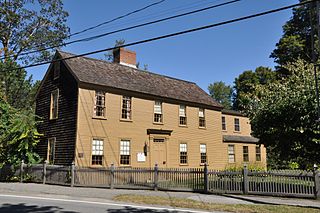
The Adams–Clarke House is a historic late First Period house in Georgetown, Massachusetts. Built about 1725, it retains a number of features transitional between the First and Second periods of colonial architecture. It was listed on the National Register of Historic Places in 1990.

The Peter Woodbury House is a historic First Period house in Beverly, Massachusetts. It is a 2+1⁄2-story wood-frame structure, five bays wide, with a side-gable roof, large central chimney, and clapboard siding. Like most surviving First Period houses, this one was built in stages. The earliest part, dating to c. 1696, was the right front section and chimney. The left side was built in the 18th century, as was the rear leanto, which was later raised to a full second story.
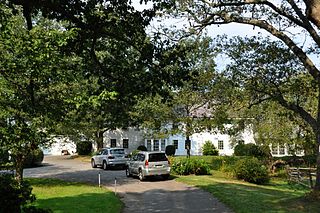
The Woodberry-Quarrels House is a historic First Period house in Hamilton, Massachusetts. The oldest part of this 2.5-story, seven-bay wood-frame house is the central doorway and the rooms to its right, which were built c. 1690 along with a central chimney that was probably removed during Federal-period alterations. Later in the First Period rooms to the left of the entry were added, and there have been a series of alterations and additions since then. The First Period core of the house survived the major Federal-era changes, and the house retains much decorative work from that period.

The Ephraim Davis House is a historic First Period house on Merrimack Road, north of the junction with Amesbury Line Road in Haverhill, Massachusetts. It is now an outbuilding of a farm, functioning as a garage and storage space. The first part of the 2+1⁄2-story house was built in 1705 by Ephraim Davis, who married in that year. This consisted of a central chimney and rooms to its right; rooms to the left of the chimney, and a leanto section in the back, were added later in the 18th century. The house remained in the hands of Davis descendants into the late 19th century. The house has been unoccupied since 1929, and has seen a variety of farm-related uses since then. Its surviving First Period elements of note are its oak timber frame and central chimney, although it is possible the chimney is a later 18th century rebuilding.
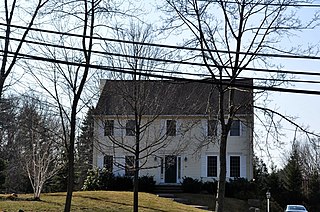
The William Foster House is a historic house in Andover, Massachusetts. The core of this house is a three-bay two-story late First Period structure built c. 1720. It was added onto about 1750, adding a two-story one-room ell to the southwest corner of the house. A new chimney core was added on the north side late in the 18th century, and a second two-story wing was added on the northwest. Although the house is traditionally dated to c. 1660, the stylistic construction techniques indicate a later construction date.

The Gott House is a historic late First Period house in Rockport, Massachusetts. The plank-framed gambrel-roofed cottage was built in 1702, exhibiting the transitional nature of the construction techniques used, and the gambrel roof, which is not a normal First Period feature. It also features 2 dormers that were added some time later. The first part built was the right side and the central chimney; this was extended with the rooms left of the chimney later in the Second Period. The interior retains significant Second Period trim and decoration. The house has never been sold, and has been handed down through the generations to its current occupants.

The Zaccheus Gould House is a historic First Period house in Topsfield, Massachusetts. The oldest part of the house was built c. 1670, probably for Zaccheus Gould by John Gould, one of the founders of Topsfield. The house is a 2+1⁄2-story five-bay wood-frame structure. The older portion of the house is on the right of the central chimney; the portion on the left is estimated to have been added c. 1700. The workmanship on the exposed framing elements inside the house suggests that the same workman also worked on the Stephen Foster House.

The Samuel March House is a historic First Period house in West Newbury, Massachusetts. The two-story wood-frame house was built in two sections, beginning in the later years of the 17th century. The first portion built was the right three bays of the house, which at that time included a chimney located on the left side. The second portion, also built during the First Period, added the two bays to the left. At some point during the Georgian period, the large central chimney was removed and replaced with two narrow brick chimney, a reflection of changing taste. The front facade is five bays wide, with a slightly larger central bay. The front door is framed by a Georgian surround with pilasters and an entablature.
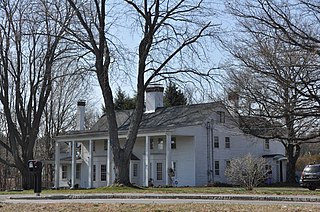
The Sawyer House is a historic First Period house in Boxford, Massachusetts. It is a 2+1⁄2-story central-chimney house with an attached rear two-story wing. A two-story full-width portico supported by seven turned columns shelters the front of the house. Like many First Period houses, this one was built in stages, and exhibits a variety of architectural styles despite its early origins. The first portion to be built was the center chimney and the two-story section to its right, in c. 1700. Later in the First Period the rooms to the left of the chimney were added. The rear wing was added in the 19th century, as was the front portico. There two further additions in the 20th century, including a sun room at the rear where the 19th-century addition meets the main house, and single-story shed-roofed addition on the west gable end, running the full depth of the house.

The Capt. John Thorndike House is a historic First Period house in Beverly, Massachusetts. It is a 2.5-story wood-frame house with a central chimney and a raised leanto section in back. The house, like many First Period houses, was built in several stages. The oldest part, the chimney and the right side, was built as a two-story section with leanto, likely in 1702. This particular type of original sections is rare among First Period houses. Later in the first period the left side of the house was built, but without a leanto section. The left side leanto was added later in the 18th century, and part of the leanto section was raised by a shed dormer in the 19th century.

The Ephraim Buck House is a historic First Period house in Wilmington, Massachusetts. Construction of the house has been dated to c. 1704 by deeds, although local histories suggest part of it may be older. Analysis of its framing suggests that it may have been built in phases: the first phase would have included the front half of the house, along with a central chimney, while the back portion of the house, along with a new chimney, would have been added later in the 18th century. The house is distinctive for having "Beverly jogs" on both sides of the house; this is a portion of the rear section that projects from the side of the house. The house was supposedly built by Roger Buck, an early colonial settler, and his son Ephraim, and was originally occupied by two families. Its exterior was restyled c. 1770 to give it Federal period styling, including a front door entry with 3/4 length sidelight windows and an entablature.
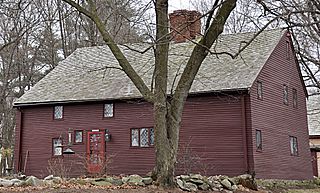
The Phineas Upham House is a historic house at 255 Upham Street in Melrose, Massachusetts. Built in the early 18th century, it is a well preserved example of First Period architecture. Owned by a family association, it is only occasionally open to the public. It was added to the National Register of Historic Places in 1990.

The Carroll–Hartshorn House is a historic First Period house at 572 Haverhill Street in Reading, Massachusetts. Built c. 1700, it is one of the oldest buildings in Reading, set on an early route between Wakefield and Haverhill. It has a classic two-story, five-bay, central-chimney plan, with a rear shed extension giving the house a saltbox appearance. Its windows, some still with original surrounds, are narrower and taller than typical for the period. The property was owned by generations of the Hartshorn family.

The Richard Nichols House is a historic late First Period house at 483 Franklin Street in Reading, Massachusetts, United States. It is a 2+1⁄2-story wood-frame structure, six bays wide, with a side gable roof, clapboard siding, rubblestone foundation, and an entry in the third bay from the left, with a chimney behind. The oldest portion of this house, probably a three bay section with chimney, was built c. 1733, and expanded to five, and then six, bays later in the 18th century. The house, along with extensive landholdings, remained in the locally prominent Nichols family until the late 19th century.

The Daniel Morse III House is a historic First Period house at 210 Farm Road in Sherborn, Massachusetts. With its oldest portion dating to about 1710, it is one of the town's oldest surviving buildings. It was listed on the National Register of Historic Places in 1986.
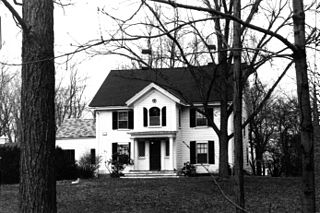
The Williams–Linscott House was a historic First Period house at 357 William Street in Stoneham, Massachusetts. The oldest part of the house was said to date to c. 1712, but it is unclear to which part of the house this referred, on account of major alterations the house in the 18th and 19th centuries. It is believed to have begun as a four-room two-story structure built around a central chimney. This underwent significant alteration during the Federal period, including replacing the center chimney with smaller side chimneys, and the construction of four more rooms in front of the original four. Sometime around 1850 Micah Williams, a prosperous farmer, again refashioned the house in the then-popular Italianate style.

The Elias Boardman House is a historic house at 34 Salem Street in Wakefield, Massachusetts. Built in 1820, it is one of the city's most elaborate examples of Federal period architecture. It was built by Elias Boardman, and was dubbed Boardman's Folly for its extravagance. It was listed on the National Register of Historic Places in 1989.
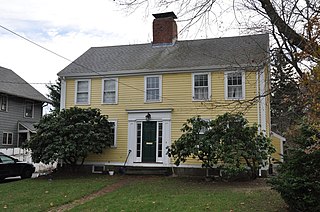
The William Stimpson House is a historic house at 22 Prospect Street in Wakefield, Massachusetts. The 2+1⁄2-story timber-frame house was built sometime before 1795, probably by William Stimpson, son of the local doctor. It has conservative Federal styling, most notably due to its central chimney rather than the more typical twin chimneys of the period. The building's internal layout and two kitchen fireplaces suggest that it was built as a two-family residence.

The Phineas Thurston House is a historic house on Old Silo Road in Barnet, Vermont. Built about 1787, it is one of the oldest surviving houses in northeastern Vermont, and one of the best-preserved early houses in Barnet. It was listed on the National Register of Historic Places in 1989.























